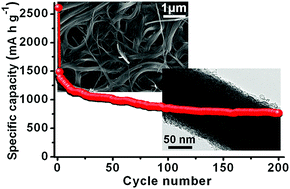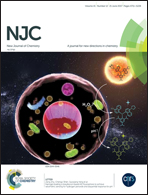A bio-inspired nanofibrous silicon/carbon composite as an anode material for lithium-ion batteries†
Abstract
A bio-inspired nanofibrous silicon/carbon composite composed of a thin silicon layer consisting of fine silicon nanocrystallites conformally coated on carbon nanofibers was prepared by employing a natural cellulose substance (e.g. ordinary laboratory filter paper) as both a scaffold and a carbon source. The current synthetic method results in much more uniform and complete silicon coating on the carbon nanofibers. And the thickness of the silicon layer in the composite can be facilely controlled. When used as an anode material for lithium-ion batteries, the composite showed improved electrochemical performances due to the three-dimensional porous network structure of the carbon fiber scaffold and the thin silicon layer. Such a silicon/carbon composite with 25.7 wt% of silicon content and a silicon layer with a thickness of ca. 40 nm exhibited good cycling stability with a specific capacity of 750.6 mA h g−1 after 150 charge/discharge cycles at a current density of 100 mA g−1. Further coating of an additional carbon layer or depositing silver nanoparticles onto the surfaces of the silicon/carbon nanofibers resulted in much more improved electrochemical performances, and specific capacities of 775.3 and 1018.7 mA h g−1 were delivered by the corresponding composites resulting after 150 cycles at 100 mA g−1, respectively.



 Please wait while we load your content...
Please wait while we load your content...